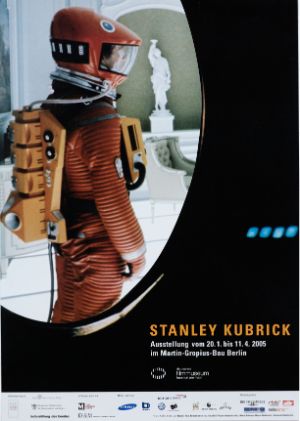Exhibition
Stanley Kubrick

Poster of the exhibition “Stanley Kubrick” Design: Steenbrink Vormgeving, Berlin
From 20 January to 18 April 2005 the Deutsches Filmmuseum Frankfurt am Main (German Film Musum) will present a major exhibition on the work of the world-famous American film director Stanley Kubrick (1928-99) in the Martin-Gropius-Bau.
Only a few directors have understood, like Kubrick, how to fascinate the audience and disturb them at the same time. His films are among the most influential contributions to recent film history; the visual worlds he has created – for example in 2001: A SPACE ODYSSEY (GB/USA 1965/68) – have fundamentally broadened the range of cinematic possibilities and set new standards.
With the support of Kubrick’s widow Christiane and of Jan Harlan, his closest collaborator over the course of many years, an archivist from the Deutsches Filmmuseum Frankfurt am Main spent eight months sifting through Kubrick’s estate. A representative portion of this collection, including photos and letters, original props and costumes, screenplays and production materials, will be made available to the public in an extensive exhibition.
The exhibition will display iconographic objects, such as the Star Child from 2001: A SPACE ODYSSEY, the little dresses of the sisters from THE SHINING or the “Born to Kill” helmet worn by Private Joker in FULL METAL JACKET. It will also explain technical camera processes, such as the Steadicam or front projection, and show technical equipment, including the Eyemo camera which Kubrick used during the shooting of KILLER’S KISS. Exact models were produced specially for the exhibition: the War Room from DR. STRANGELOVE, the labyrinth from THE SHINING and the centrifuge from 2001: A SPACE ODYSSEY.
Kubrick’s uncompleted film projects, NAPOLEON and ARYAN PAPERS, are also taken into account: extensive research documents, photographs and shooting plans confirm how far along these projects had progressed.
The films with the most enduring reception are one of the points of emphasis within the exhibition: 2001: A SPACE ODYSSEY and A CLOCKWORK ORANGE. The curators designed a walk-in “dimensionless” space modelled on the inside of the HAL 9000 computer in 2001: A SPACE ODYSSEY. The area devoted to A CLOCKWORK ORANGE is based on the set design of the Korova Milkbar.
An audiovisual lecture in a “black box” explains the use of music in Kubrick’s films. A digital picture show traces Stanley Kubrick’s biographical stations by means of previously unpublished photographs.
An audioguide that goes into the subject matter more deeply and explains the exhibits will lead the visitor through the exhibition. The English text will be spoken by Malcolm McDowell, the protagonist of A CLOCKWORK ORANGE, while the narrator of the German text is Jörg Pleva, who dubs the voice of the main actor in a number of Kubrick’s films.
Organizer: An exhibition of the Deutsches Filmmuseum and the Deutsches Architektur Museum, Frankfurt am Main.
In cooperation with the Filmmuseum Berlin / Stiftung Deutsche Kinemathek and the Martin-Gropius-Bau, Berlin
Made possible by the Kulturstiftung des Bundes and the Hauptstadtkulturfonds
Supported by the Berlin International Film Festival
Curator: Hans-Peter Reichmann, Frankfurt/Main
Venues: Frankfurt/Main: Deutsches Filmuseum, Berlin: Martin-Gropius-Bau, Rom: Palazzo delle Esposizioni, Melbourne: Australian Center for the Moving Image, Gent: Carmers Kloister, Zürich: Kulturhaus, Valencia: Museo de las Artes Audiovisuales (MUAA)